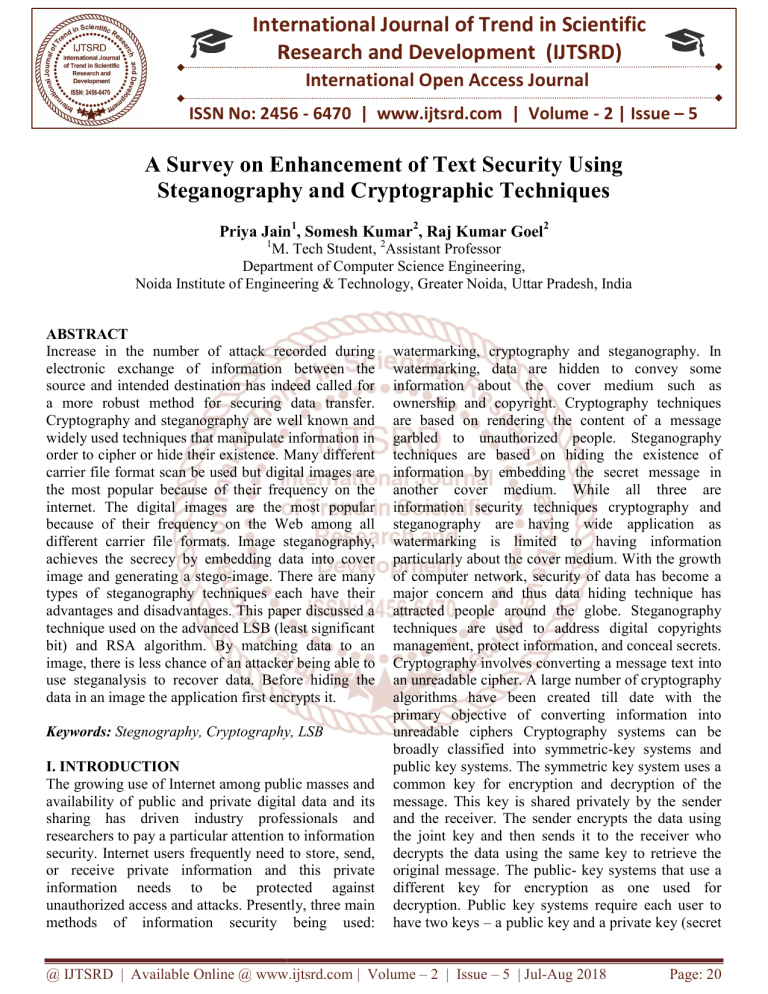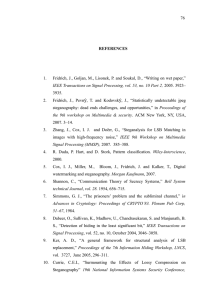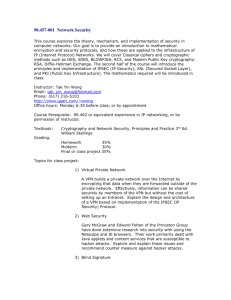
International Journal of Trend in Scientific
Research and Development (IJTSRD)
International Open Access Journal
ISSN No: 2456 - 6470 | www.ijtsrd.com | Volume - 2 | Issue – 5
A Survey on
n Enhancement of Text Security Using
U
Steganography aand Cryptographic Techniques
Priya Jain1, Somesh Kumar2, Raj Kumar Goel2
1
M. Tech Student, 2Assistant Professor
Department of Computer Science Engineering,
Noida Institute of Engineering & Technology, Greater Noida, Uttar Pradesh, India
ABSTRACT
Increase in the number of attack recorded during
electronic exchange of information between the
source and intended destination has indeed called for
a more robust method for securing data transfer.
Cryptography and steganography are well known and
widely used techniques that manipulate information in
order to cipher or hide their existence. Many different
carrier file format scan be used but digital images are
the most popular because of their
eir frequency on the
internet. The digital images are the most popular
because of their frequency on the Web among all
different carrier file formats. Image steganography,
achieves the secrecy by embedding data into cover
image and generating a stego-image.. There are many
types of steganography techniques each have their
advantages and disadvantages. This paper discussed a
technique used on the advanced LSB (least significant
bit) and RSA algorithm. By matching data to an
image, there is less chance of an attacker
ttacker being able to
use steganalysis to recover data. Before hiding the
data in an image the application first encrypts it.
Keywords: Stegnography, Cryptography, LSB
I. INTRODUCTION
The growing use of Internet among public masses and
availability of public and private digital data and its
sharing has driven industry professionals and
researchers to pay a particular attention to information
security. Internet users frequently need to sstore, send,
or receive private information and this private
information needs to be protected against
unauthorized access and attacks. Presently, three main
methods of information security being used:
watermarking, cryptography and steganography. In
watermarking,
ermarking, data are hidden to convey some
information about the cover medium such as
ownership and copyright. Cryptography techniques
are based on rendering the content of a message
garbled to unauthorized people. Steganography
techniques are based on hiding
hidi
the existence of
information by embedding the secret message in
another cover medium. While all three are
information security techniques cryptography and
steganography are having wide application as
watermarking is limited to having information
particularly
larly about the cover medium. With the growth
of computer network, security of data has become a
major concern and thus data hiding technique has
attracted people around the globe. Steganography
techniques are used to address digital copyrights
management, protect information, and conceal secrets.
Cryptography involves converting a message text into
an unreadable cipher. A large number of cryptography
algorithms have been created till date with the
primary objective of converting information into
unreadable ciphers Cryptography systems can be
broadly classified into symmetric-key
symmetric
systems and
public key systems. The symmetric key system uses a
common key for encryption and decryption of the
message. This key is shared privately by the sender
and the receiver. The sender encrypts the data using
the joint key and then sends it to the receiver who
decrypts the data using the same key to retrieve the
original message. The public-- key systems that use a
different key for encryption as one used for
decryption. Publicc key systems require each user to
have two keys – a public key and a private key (secret
@ IJTSRD | Available Online @ www.ijtsrd.com | Volume – 2 | Issue – 5 | Jul-Aug 2018
Page: 20
International Journal of Trend in Scientific Research and Development (IJTSRD) ISSN: 2456-6470
key). The sender of the data encrypts the message
using the receivers public key. The receiver then
decrypts this message using his private key. In this
paper describes all the techniques and proposed works
based on cryptography and steganography.
II. LITERATURE REVIEW:
The word steganography is originally derived from
Greek words which mean “Covered Writing”. It is
defined as "hiding information within a noise; a way
to supplement encryption, to prevent the existence of
encrypted data from being detected" [1]. It has been
used in various forms for thousands of years. In the
5th century BC Histaiacus shaved a slave’s head,
tattooed a message on his skull and the slave was
dispatched with the message after his hair grew back [
2, 4,5,7]. Basically, the purpose of cryptography and
steganography is to provide secret communication.
Steganography can be used to cloak hidden messages
in image, audio, video and even text files. According
to [7], the two most common methods used for hiding
information inside a picture, audio and video files are
LSB (Least Significant Bit) and Injection. The survey
of Johnson [6] appeared in the “Information hiding”
book, which limits its distribution compared to a
Journal paper which can be more affordable. The
classification, herein, of the techniques and that of
Johnson are different. Johnson classify steganography
techniques into: Substitution systems, transform
domain techniques, spread spectrum techniques,
statistical methods, distortion techniques, and cover
generation methods. Johnson survey neither talks
about the history of steganography nor its
applications.
Several techniques have been proposed by researchers
for securing electronic communication. In the
research work of [9], the researchers proposed
cryptography and steganography for securing data
transfer using images as cover objects for
steganography and key for the cryptography. The
performance of the proposed ISC (Image-Based
Steganography and Cryptography) system was
presented and the system was compared with F5
algorithm. Also, [10] proposed method that described
two steps for hiding secret information by using the
public steganography based on matching method. The
first step, finds the shared stego-key between the two
communication parties (Alice and Bob) over the
networks by applying Diffie Hellman Key exchange
protocol. The second step in the proposed method is
that, the sender uses the secret stego-key to select
pixels that it will be used to hide.
Alice
Bob
Perform partial
key validation on R
Produce random integer r
in [1, n – 1]
Compute R = rG
Computes
KB = h.dB.R = (Kx, Ky )
Compute
K = hrQB = (Kx, Ky)
Compute
k1||k2 = KDF(Kx)
Compute
k1||k2 = KDF(Kx)
Sends (R, c, t)
Verify that t = MACk2(c)
Computes m = ENCk1–1(c)
Compute
c = ENCk1(m)
Compute
t = MACk2(c)
m is the
decrypted Plain
Text message
@ IJTSRD | Available Online @ www.ijtsrd.com | Volume – 2 | Issue – 5 | Jul-Aug 2018
Page: 21
International Journal of Trend in Scientific Research and Development (IJTSRD) ISSN: 2456-6470
III. CRYPTOGRAPHY
Cryptography is the art and science of achieving
security by encoding messages to make them non
readable. In this, the structure of message is
scrambled to make it meaningless and unintelligible
unless the decryption key is available. Basically,
cryptography offers the ability of transmitting
information between persons in a way that prevents a
third party from reading it. Cryptography can also
provide authentication for verifying the identity of
something or someone. Cryptanalysis is the reverse
engineering of cryptography. There are several ways
of classifying cryptographic algorithms. The three
types of algorithms are:
1. Secret key Cryptography: Use a single key for
both encryption and decryption
2. Public Key Cryptography: Use one key for
encryption and another for decryption.
3. Hash
Functions:
Use
a
mathematical
transformation
to
irreversibly
"encrypt"
information
IV. STEGANOGRAPHY TECHNIQUES
In this method the secret data is embedded directly in
the intensity of pixels. It means some pixel values of
the image are changed directly during hiding data.
Spatial domain techniques
following categories:
are
classified
into
1. Spatial domain techniques
I.
Least significant bit (LSB)
II.
Pixel value differencing (PVD)
III.
Edges based data embedding method (EBE)
IV.
Random pixel embedding method (RPE)
V.
Mapping pixel to hidden data method
VI.
Labeling or connectivity method
VII.
Bit Plane Complexity Segmentation (BPCS)
I. LSB: this method is most commonly used for hiding
data. In this method the embedding is done by replacing
the least significant bits of image pixels with the bits of
secret data. The image obtained after embedding is almost
similar to original image because the change in the LSB of
image pixel does not bring too much differences in the
image.
II. BPCS: In this segmentation of image are used by
measuring its complexity. Complexity is used to
determine the noisy block. In this method noisy
blocks of bit plan are replaced by the binary patterns
mapped from a secret data
III. PVD: In this method, two consecutive pixels are
selected for embedding the data. Payload is
determined by checking the difference between two
consecutive pixels and it serves as basis for
identifying whether the two pixels belongs to an edge
area or smooth area.
2. Spread Spectrum Technique:
The concept of spread spectrum is used in this
technique. In this method the secret data is spread
over a wide frequency bandwidth. The ratio of signal
to noise in every frequency band must be so small that
it become difficult to detect the presence of data. Even
if parts of data are removed from several bands, there
would be still enough information is present in other
bands to recover the data. Thus it is difficult to
remove the data completely without entirely
destroying the cover .It is a very robust technique
mostly used in military communication.
3. Statistical Technique:
In the technique message is embedded by changing
several properties of the cover. It involves the
splitting of cover into blocks and then embedding one
message bit in each block. The cover block is
modified only when the size of message bit is one
otherwise no modification is required.
4. Transform Domain Technique:
In this technique; the secret message is embedded in
the transform or frequency domain of the cover. This
is a more complex way of hiding message in an
image. Different algorithms and transformations are
used on the image to hide message in it. Transform
domain techniques are broadly classified such as i)
Discrete Fourier transformation technique (DFT) ii)
Discrete cosine transformation technique (DCT) iii)
Discrete Wavelet transformation technique (DWT) iv)
Lossless or reversible method (DCT) v)Embedding in
coefficient bits.
V. COMBINED CRYPTO STEGANOGRAPHY
Steganography is not the same as cryptography Data
hiding techniques have been widely used to
transmission of hiding secret N message for long
time. Ensuring data security is a big challenge for
computer users. Business men, professionals, and
home users all have some important data that they
want to secure from others. Even though both
methods provide security, to add multiple layers of
security it is always a good practice to use
@ IJTSRD | Available Online @ www.ijtsrd.com | Volume – 2 | Issue – 5 | Jul-Aug 2018
Page: 22
International Journal of Trend in Scientific Research and Development (IJTSRD) ISSN: 2456-6470
Cryptography and Steganography together. By
combining, the data encryption can be done by a
software and then embed the cipher text in an image
or any other media with the help of stego key. The
combination of these two methods will enhance the
security of the data embedded. This combined
chemistry will satisfy the requirements such as
capacity, security and robustness for secure data
transmission over an open channel.
A pictorial representation of the combined concept of
cryptography and steganography is depicted in figure
2.
Plain Text
Encryptio
Cipher text
Cover image
Stego Image
Plain Text
Decryption
Cipher Text
Figure 2: Systematic graphical representation of
combined Cryptography and Steganography
In figure 2, both the methods are combined by
encrypting message using cryptography and then
hiding the encrypted message using steganography.
The resulting stego-image can be transmitted without
revealing that secret information is being exchanged.
Furthermore, even if an attacker were to defeat the
steganography technique to detect the message from
the stego-object, he would still require the
cryptographic decoding key to decipher the encrypted
message
The steganography approaches can be divided into
three types [8]:
1. Pure Steganography: This technique simply uses
the steganography approach only without combining
other methods. It is working on hiding information
within cover carrier.
2. Secret Key Steganography: The secret key
steganography use the combination of the secret key
cryptography technique and the steganography
approach. The idea of this type is to encrypt the secret
message or data by secret key approach and to hide
the encrypted data within cover carrier.
3. Public Key Steganography: The last type of
steganography is to combine the public key
cryptography approach and the steganography
approach. The idea of this type is to encrypt the secret
data using the public key approach and then hide the
encrypted data within cover carrier.
VI. CONCLUSION
A secured advanced based LSB technique for image
steganography has been proposed. An efficient
steganography method for embedding secret messages
into cover images without producing any major
changes has been accomplished through advancedLSB method. In this work, a new way of hiding
information in an image with less variation in image
bits have been proposed, which makes our technique
secure and more efficient than LSB. This technique
also applies a cryptographic method i.e. RSA
algorithm to secure the secret message so that it is not
easy to break the encryption without the key. RSA
algorithm itself is very secure that’s why we used in
this technique to increase the security of the secret
message.
REFERENCES
1. R. Chandramouli, M. Kharrazi, N. Memon,
“Image
Steganography
and
Steganalysis:
Concepts
and
Practice
“Andre
Leier.
Cryptography with DNA Binary Strands. Bio
Systems, 57:13–22, April 2000. Communications,
16(4), pp. 474-481.
2. Dipti, K. S. and Neha, B. 2010. Proposed System
for Data Hiding Using Cryptography and
Steganography. International Journal of Computer
Applications. 8(9), pp. 7-10.
3. Jasleen Kour, “Steganography Techniques –A
Review Paper”, International Journal of Emerging
Research inn Management &Technology,
Volume-3, Issue-5, May 2014, pp 132-135.
4. Jayaram, P., Ranganatha, H. R. and Anupama, H.
S. 2011. Information Hiding Using Audio
Steganography – A Survey. International Journal
of Multimedia and Its Application, 3(3), pp. 8696.
5. Jie Chen. A DNA-based, bio-molecular
cryptography design. In Circuits and Systems,
2003. ISCAS ’03. Proceedings of the 2003
International Symposium on, volume 3, pages III–
822-825 vol.3, May 2003.
@ IJTSRD | Available Online @ www.ijtsrd.com | Volume – 2 | Issue – 5 | Jul-Aug 2018
Page: 23
International Journal of Trend in Scientific Research and Development (IJTSRD) ISSN: 2456-6470
6. Mark D. G. 2003. Chameleon Image
Steganography- Technical Paper. Retrieved 14th
July,
2012
from
http://faculty.ksu.edu.sa/ghazy/Steg/References/re
f13.pdf.
7. N. F. Johnson and S. C. Katzenbeisser, “A survey
of
steganographic
techniques”,
in:
S.
Katzenbeisser and F.A.P. Petitcolas, (ed.) (2000)
Information hiding techniques for steganography
and digital watermarking, Norwood: Artech
House,
8. Niels, P. and Peter, H 2003. Hide and Seek: An
Introduction to Steganography. IEEE Computer
Society. IEEE Security and Privacy, pp. 32-44.
9. R. J. Anderson and F. A. P. Petitcolas (2001) On
the limits of the Stegnography, IEEE Journal
Selected Areas in
10. Raphael, A. J., and Sundaram, V. 2011.
Cryptography and Steganography - A Survey.
International Journal of Computer Technology
Application, 2(3), ISSN: 2229-6093, pp. 626-630.
11. S. B. Sadkhan, Cryptography: Current status and
future trends, in: Proceedings of IEEE
International Conference on Information &
Communication Technologies: From Theory to
Applications, Damascus. Syria, April 19-23, 2004,
pp. 417-418.
12. T. Morkel, J. H. P. Eloff, M. S. Olivier, ”An
Overview of Image Steganography”, Information
and Computer Security Architecture (ICSA)
Research Group, Department of Computer
Science, University of Pretoria, SA.
@ IJTSRD | Available Online @ www.ijtsrd.com | Volume – 2 | Issue – 5 | Jul-Aug 2018
Page: 24



